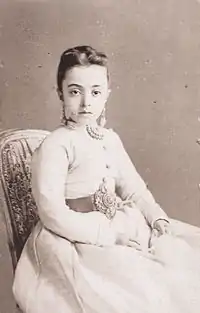| Saliha Sultan | |||||
|---|---|---|---|---|---|
 | |||||
| Born | 10 August 1862 Dolmabahçe Palace, Constantinople, Ottoman Empire (now Istanbul, Turkey) | ||||
| Died | c. 1941 (aged 78–79) Cairo, Egypt | ||||
| Burial | |||||
| Spouse |
Ahmed Zülkefil Pasha
(m. 1889) | ||||
| Issue | Kamile Hanımsultan | ||||
| |||||
| Dynasty | Ottoman | ||||
| Father | Abdulaziz | ||||
| Mother | Dürrinev Kadın | ||||
| Religion | Sunni Islam | ||||
Fatma Saliha Sultan (Ottoman Turkish: فاطمہ صالحہ سلطان; "who abstain one and "devoutus one"; 10 August 1862 – 1941) was an Ottoman princess, the daughter of Ottoman Sultan Abdulaziz and Dürrinev Kadın.
Early life
Saliha Sultan was born on 10 August 1862 in at the Dolmabahçe Palace.[1][2][3] Her father was Sultan Abdulaziz, son of Mahmud II and Pertevniyal Sultan, and her mother was Dürrinev Kadın, the daughter of Prince Mahmud Dziapş-lpa and Princess Halime Çikotua.[4] She was the eldest daughter of her father and the second child of her mother. She was the younger full sister of crown prince Şehzade Yusuf Izzeddin and the elder sister of Şehzade Mehmed Selim, died at the age of one[1][5]
In 1869, she met with the Princess of Wales Alexandra of Denmark, when the latter visited Istanbul with her husband Prince of Wales Edward (future Edward VII).[6]
Her father, Abdülaziz was deposed by his ministers on 30 May 1876, his nephew Murad V became the Sultan.[7] He was transferred to Feriye Palace the next day.[8] Her mother, and other women of Abdülaziz's entourage didn't wanted to leave the Dolmabahçe Palace. So they were grabbed by hand and were sent out to the Feriye Palace. In the process, they were searched from head to toe and everything of value was taken from them.[9] On 4 June 1876,[10] Abdülaziz died under mysterious circumstances.[11]
Saliha Sultan, a fourteen-year-old girl, continued to live in the Feriye Palace with her mother and nineteen-year-old brother.[12]
Marriage
In 1875, Saliha Sultan was engaged to Ibrahim Hilmi Pasha, the son of Khedive of Egypt Ismail Pasha.[5] However, the engagement was broken off, after the dismissal of her father in 1876.[13]
In 1889 Sultan Abdul Hamid II arranged her trousseaux and marriage together with her two sisters, princesses Nazime Sultan and Esma Sultan, as well his own daughter Zekiye Sultan.[14] She married Ahmed Zülkefil Pasha, the son of Kurdzade Ismail Hakkı Pasha on 20 April 1889 in the Yıldız Palace.[1][5][15]
The couple were given a waterfront palace located in Fındıklı.[16] The two together had a daughter named Kamile Hanımsultan, born in 1890 and died in 1896 at the age of six.[5][15]
Following the imperial family was sent to exile in 1924, Saliha and her husband settled in Cairo, Egypt, were they lived in poverty.[15]
Death
Saliha Sultan died in 1941 aged around 79, in Cairo, Egypt and was buried in the mausoleum of Khedive Tewfik.[13][17] Her husband died the same year.[15]
Honours
| Styles of Saliha Sultan | |
|---|---|
.svg.png.webp) | |
| Reference style | Her Imperial Highness |
| Spoken style | Your Imperial Highness |
Issue
| Name | Birth | Death | Notes |
|---|---|---|---|
| Kamile Hanımsultan | c. 1890 | c. 1896 | Died young, and buried in tomb of Sultan Mahmud II |
Ancestry
| Ancestors of Saliha Sultan (daughter of Abdulaziz) | |||||||||||||||||||||||||||||||||||||||||||||||||||||||||||||||||||||||||||||||||||||||||||||||||||||||||||||||||||||||||||||||||||||||||||||||||||||||||||||||||||||||||||||||||||||||||||||||||||||||||||||||||||||||||||||||||||||||||||||||||||||||||||||||||||||||||
|---|---|---|---|---|---|---|---|---|---|---|---|---|---|---|---|---|---|---|---|---|---|---|---|---|---|---|---|---|---|---|---|---|---|---|---|---|---|---|---|---|---|---|---|---|---|---|---|---|---|---|---|---|---|---|---|---|---|---|---|---|---|---|---|---|---|---|---|---|---|---|---|---|---|---|---|---|---|---|---|---|---|---|---|---|---|---|---|---|---|---|---|---|---|---|---|---|---|---|---|---|---|---|---|---|---|---|---|---|---|---|---|---|---|---|---|---|---|---|---|---|---|---|---|---|---|---|---|---|---|---|---|---|---|---|---|---|---|---|---|---|---|---|---|---|---|---|---|---|---|---|---|---|---|---|---|---|---|---|---|---|---|---|---|---|---|---|---|---|---|---|---|---|---|---|---|---|---|---|---|---|---|---|---|---|---|---|---|---|---|---|---|---|---|---|---|---|---|---|---|---|---|---|---|---|---|---|---|---|---|---|---|---|---|---|---|---|---|---|---|---|---|---|---|---|---|---|---|---|---|---|---|---|---|---|---|---|---|---|---|---|---|---|---|---|---|---|---|---|---|---|---|---|---|---|---|---|---|---|---|---|---|---|---|---|---|
| |||||||||||||||||||||||||||||||||||||||||||||||||||||||||||||||||||||||||||||||||||||||||||||||||||||||||||||||||||||||||||||||||||||||||||||||||||||||||||||||||||||||||||||||||||||||||||||||||||||||||||||||||||||||||||||||||||||||||||||||||||||||||||||||||||||||||
References
- 1 2 3 Uluçay 2011, p. 234.
- ↑ Sakaoğlu 2008, p. 645.
- ↑ Uçan, Lâle (2019). Dolmabahçe Sarayı'nda Çocuk Olmak: Sultan Abdülaziz'in Şehzâdelerinin ve Sultanefendilerinin Çocukluk Yaşantılarından Kesitler. FSM İlmî Araştırmalar İnsan ve Toplum Bilimleri Dergisi. p. 232.
- ↑ Açba, Leyla (2004). Bir Çerkes prensesinin harem hatıraları. L & M. p. 22. ISBN 978-9-756-49131-7.
- 1 2 3 4 Sakaoğlu 2008, p. 643.
- ↑ Grey, Maria Georgina Shirreff (1870). Journal of a Visit to Egypt, Constantinople, the Crimea, Greece, &c:In the Suite of the Prince and Princess of Wales. Harper. pp. 165–166.
- ↑ Zürcher, Erik J. (October 15, 2004). Turkey: A Modern History, Revised Edition. I.B.Tauris. p. 73. ISBN 978-1-850-43399-6.
- ↑ Shaw, Stanford J.; Shaw, Ezel Kural (1976). History of the Ottoman Empire and Modern Turkey: Volume 2, Reform, Revolution, and Republic: The Rise of Modern Turkey 1808-1975, Volume 11. Cambridge University Press. p. 164. ISBN 978-0-521-29166-8.
- ↑ Brookes 2010, p. 40.
- ↑ Davison, Roderic H. (December 8, 2015). Reform in the Ottoman Empire, 1856-1876. Princeton University Press. p. 341. ISBN 978-1-400-87876-5.
- ↑ Brookes 2010, p. 43.
- ↑ Şerofoğlu, Ömer Faruk (2004). Abdülmecid Efendi, Ottoman prince and painter. YKY. p. 24. ISBN 978-9-750-80883-8.
- 1 2 Brookes 2010, p. 289.
- ↑ Brookes 2010, p. 159.
- 1 2 3 4 Adra, Jamil (2005). Genealogy of the Imperial Ottoman Family 2005. p. 16.
- ↑ Tuğlacı, Pars; Güler, Ara; Avcıdırlar, Mehmet; Dinç, Yılmaz (1981). Osmanlı mimarlığında batılılaşma dönemi ve Balyan ailesi. İnkılâp ve Aka. p. 206.
- ↑ Sakaoğlu 2008, p. 644.
- 1 2 3 Yılmaz Öztuna (1978). Başlangıcından zamanımıza kadar büyük Türkiye tarihi: Türkiye'nin siyasî, medenî, kültür, teşkilât ve san'at tarihi. Ötüken Yayınevi. p. 165.
Sources
- Brookes, Douglas Scott (2010). The Concubine, the Princess, and the Teacher: Voices from the Ottoman Harem. University of Texas Press. ISBN 978-0-292-78335-5.
- Sakaoğlu, Necdet (2008). Bu mülkün kadın sultanları: Vâlide sultanlar, hâtunlar, hasekiler, kadınefendiler, sultanefendiler. Oğlak Yayıncılık. ISBN 978-9-753-29623-6.
- Uluçay, Mustafa Çağatay (2011). Padişahların kadınları ve kızları. Ankara: Ötüken. ISBN 978-9-754-37840-5.